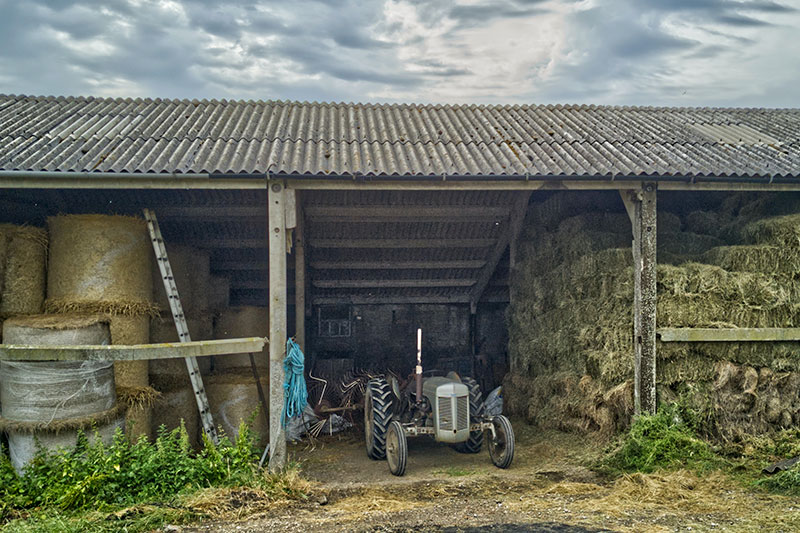Asbestos removal on farms and from UK agricultural buildings
Asbestos wasn’t banned in the United Kingdom until the end of 1999. However, many farm buildings were built before then, when asbestos was still commonly used in construction. That means that today, asbestos is still present on many farm properties.
The health risks of asbestos are severe and can be life-threatening. Diseases caused by asbestos exposure often require aggressive treatments. Asbestosis, lung cancer, and mesothelioma can result from asbestos exposure. Additionally, the risk of developing other cancers, such as colon cancer, goes up if the patient has another asbestos-related illness.
Knowing the potential risks of asbestos and the common places where it can be found on farms is integral to keeping everyone safe.
Where can asbestos be found? Common sources of asbestos on farms
Most farms have asbestos-containing materials (ACMs) somewhere, though how much asbestos is present varies from farm to farm. Common sources include:
- Cement sheets and panels
- Flooring tiles and adhesives
- Gutters, pipes, and ducts
- Roofing materials
- Soil and asbestos-contaminated land
- Wall cladding and insulation
It’s also possible that asbestos was buried on the farm at some point. Buried asbestos isn’t safe, and it needs to be removed and disposed of properly. Otherwise, it can cause air, land, and water contamination.
Who is at risk?
Anybody in the vicinity of damaged ACMs is at risk of inhaling asbestos fibres. That includes tenants, workers, and visitors. At the highest risk for asbestos exposure are those who spend the most time on the property, including:
- Contractors and maintenance workers
- Family members residing on the farm
- Farmers and farmworkers
Regular farm work or property maintenance can lead to accidental ACM damage. For example, it’s possible to disturb ACMs when breaking up cement, drilling into walls, or working on hot water systems.
What are the health risks of asbestos exposure?
Individuals in the farm and agriculture industry are especially vulnerable to asbestos exposure. Whenever work is performed on the farm, there’s the potential of disturbing ACMs or buried asbestos without realising it.
Long-term asbestos exposure can result in asbestosis, which can lead to asbestos-related cancers. Symptoms of asbestosis include chest pain, cough, fatigue, shortness of breath, and wheezing. Asbestosis has no cure because the damage to the lungs can’t be reversed.
Since farm properties are usually owned by a single family and passed along to other members, tenants may feel that they know the property well enough to feel safe. Their thinking may be, “There hasn’t been a problem yet, so why worry about it?” Unfortunately, there are two huge flaws with this way of thinking.
First, asbestos fibres are usually microscopic and can’t be seen with the naked eye. There could be air contamination that’s gone unnoticed. Anyone in the vicinity could breathe in fibres without knowing.
Second, asbestos exposure can result in illnesses a decade or more in the future. Feeling safe now doesn’t mean that a life-threatening disease won’t appear later if there’s been asbestos exposure.
How do I identify asbestos on farms?
The owners or tenants of a farm property have a legal duty to determine if asbestos is present on the property and what condition the asbestos is in. The duty holder may be able to carry out inspections on their own, or they can opt to hire a professional.
Importance of asbestos surveys and assessments
It’s best to have a professional asbestos surveyor determine if ACMs are present on the property. Then, the surveyor or the owner can prepare an asbestos register and management plan.
Signs of potential ACMs
White asbestos, also called chrysotile, is the most common type of asbestos you’ll find on a farm. This kind of asbestos is light grey in colour and is often found in these areas:
- Panels between wallboards
- Corrugated roofing and/or roof cladding
- Rainwater gutters and pipes
- Mixed with blue or brown asbestos to create boiler or pipe insulation
A common sign that a building material contains asbestos is flaking or powdering on a surface that’s already damaged or has signs of wear and tear.
Engaging professionals for asbestos testing and identification
Asbestos testing and identification is the best way to keep yourself, tenants, and workers safe. Without knowing if asbestos is present, what type of asbestos is present, and its state, it’s impossible to make sound decisions about managing ACMs on your property.
A professional should carry out an asbestos management survey and create a report that includes information about the type of asbestos, where it’s located, and its condition.
What to do if asbestos is found
If asbestos is found, it’s important not to handle or disturb the ACM in any way.
These are the immediate actions to take:
- Isolate and restrict access to the affected area.
- Inform relevant parties.
- Seek advice from asbestos removal experts.
Additionally, farm employees and anyone who works in a building that contains asbestos must be told that asbestos is present and where it is.
Engaging licensed asbestos removal contractors
It’s possible that a licensed contractor will need to remove the asbestos. Or, if it’s in good condition and not posing a threat, it may be able to remain where it is. You won’t know the best course of action without the advice of an expert, though.
There’s no such thing as “safe” asbestos or a safe ACM. Regardless of the type of ACM, if its fibres release into the air and are breathed in, they’re dangerous. However, the type of materials impacts how likely it is that damage will occur. Some ACMs are more prone to breakage or damage than others.
High-risk ACMs should always be handled by a licensed contractor. These include asbestos board, insulation, and sprayed coatings.
Safe asbestos removal practices on farms
Undamaged asbestos that’s well-sealed is safest if left alone. Otherwise, if an ACM is damaged or has the potential to be damaged, it’s best to have it removed.
Some removal projects can be handled by a competent contractor, even if they’re not licensed. However, working with asbestos board, insulation, or sprayed coatings requires a licensed contractor by law.
Whoever is responsible for removing the ACMs must follow proper containment and isolation measures. These include:
- Leaving ACMs in one piece instead of breaking them up for disposal.
- Double-wrapping ACMs in heavy-duty plastic bags that won’t rip.
- Properly labelling bags that there are hazardous materials inside.
It’s also necessary for anyone working with asbestos to wear personal protective equipment (PPE). This includes items like disposable clothing and respiratory protective equipment (RPE).
Training and education
Anybody who may encounter ACMs should have asbestos awareness training and up-to-date instruction. Furthermore, those who will be working with ACMs must be competent in the tasks they’ll be carrying out. According to Farmers Weekly, employers are responsible for providing suitable training and instruction to employees who will be working with ACMs. It’s also best if workers undergo refresher training as needed.
Prevention and maintenance
Once the asbestos has been assessed and appropriate action has been taken, you’ll need a prevention and maintenance plan. This includes holding regular inspections to determine the condition of the ACMs. If there’s been a change, the issue will need to be handled immediately to keep everyone safe.
Final thoughts about asbestos removal on farms
Compliance with asbestos regulations on farms is a known problem. One reason for this is that farming is often a family business, and farm property may be passed along to family members instead of sold to a third party. Without an outside person pushing for safety guidelines to be followed, there may be a lax approach to asbestos management.
However, knowing where asbestos is present and the condition it’s in can be the difference between life and death. Though asbestos-related diseases don’t tend to show up for up until decades later, when they do, they can be life-threatening and difficult to treat.
In addition to prioritising everyone’s safety, you’ll need to have done your due diligence regarding asbestos if you choose to sell the property. The buyer will ask for information about asbestos on the property, including an asbestos survey and management plan.
It’s an absolute must that industry professionals address asbestos issues to protect their workers’ health.

Written by Mark Carter
Mark Carter is a renowned expert in asbestos management, offering clients vital guidance on compliance and safety. His expertise is invaluable for navigating asbestos regulations, ensuring both safety and legal adherence. Mark's role is central in providing effective asbestos-related solutions, helping clients achieve their business objectives with an emphasis on regulatory compliance and safety in asbestos management.

